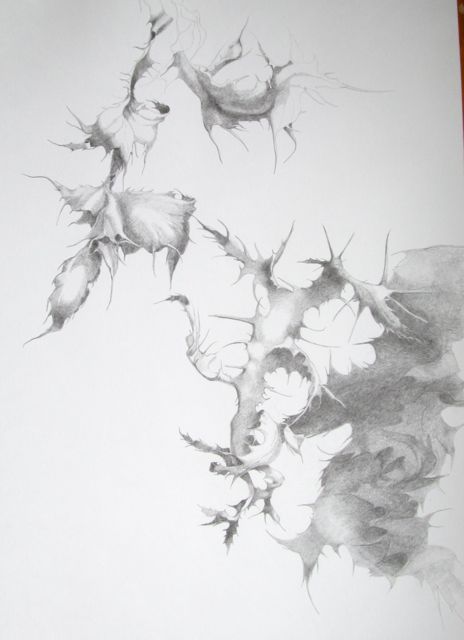 |
I think this piece is called White Lines 2013, by Jason Middlebrook.
Acrylic and spray paint on English Elm. |
I was fortunate to visit my friends Robin and Jim in Western Massachusetts a few days before the June Residency began, as we were able to visit MassMoCA, the Williams College Art Gallery and the Clark Institute. I was excited to see the show of Jason Middlebrook's wood sculptures. His patterned slices of trees are intriguing in their combinations of abstraction and wood grains. Leaning the pieces against the wall instead of hanging them or supporting them as free-standing sculpture is a more dynamic way of showing them. They look as though they could slide away from the wall and topple over, which gives them a certain excitement.
 |
Jason Middlebrook - I've Been Drawing Cliffs My Whole Life, 2013
spray paint on maple 93.625 x 41 x 1.375 in. |
Robin and I enjoyed Joseph Montgomery's show, "Five Sets Five Reps" as well. The assemblage of different materials and textures created sculptures somewhat reminiscent of early Cubism, but with the unfinished look of the 'provisional.' That is my take on them, at least.
 |
I believe this piece is titled Image One Hundred Forty-Seven, by Joseph Montgomery.
Oil, pastel, clay, lacquer, resin, sponge, paper, canvas, wax and steel wire on plastic panel.
12.5 x 9 x 2.5 in. |
The Sol Lewitt's 'wall drawings' became a total environment of dramatic color and contrast. With so many huge curving shapes, it was not hard to imagine the floor swaying slightly as if we were on a ship at sea. 65 art students completed the various murals following Lewitt's detailed instructions.
 |
| Sol Lewitt - wall drawing |
 |
| Sol Lewitt - wall drawing |
Xu Bing's Phoenix was spectacular. The accompanying book of the project's progress was fascinating, as well as the video documentary. It is amazing to notice the discarded 'junk' that was assembled together to make the enormous birds in flight. The team collected items from Beijing construction sites that were being thrown out. There were many challenges to the project, not the least of which was the interruption in construction for the Beijing Summer Olympics in 2008. The scale of each phoenix is so large, that at first you don't realize that each feather is a spade, that curling feathers are made of empty propane tanks, exhaust hoses act as fronds near the bird'd tail.
 |
| Phoenix by Xu Bing at Mass MoCA |
A special treat awaited us at Williams College.
Sunflower 6 by Joan Mitchell had been recently donated to the collection and the painting was on display in the seminar room for a few hours daily. It was wonderful to be able to see the painting up close with a magnifying glass. The textures and contours of the paint as Mitchell applied it are almost impossible to see in reproductions. I was interested to notice hairline cracks in the paint where it was particularly thick, although they do not hinder the effect of the image at all.
 |
| Examining the surface of Sunflower 6 by Joan Mitchell. |
 |
| Sunflower 6 by Joan Mitchell |
 |
| Stopping by Louise Bourgeois' sculpture at Williams College. |




















